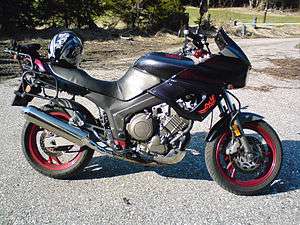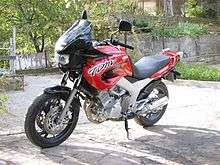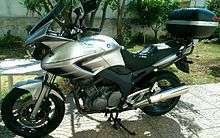Yamaha TDM850
The Yamaha TDM is an 849 cc DOHC parallel-twin motorcycle that heralded the modern "Sport touring" category. The TDM was first manufactured by the Yamaha Motor Company of Japan in 1991. The TDM has a pressed-steel frame and a dry sump engine with five valves per cylinder, (three inlet and two exhaust).
 | |
| Manufacturer | Yamaha Motor Company |
|---|---|
| Also called | TDM |
| Production | 1991- 2001 |
| Predecessor | XTZ 750 Super Tenere |
| Successor | Yamaha TDM 900 |
| Class | Sport touring |
| Engine | Mk I 850 cc liquid-cooled multi-valve parallel-twin 360-degree cranks / Mk II 850 cc liquid-cooled multi-valve crossplane parallel-twin 270-degree crank |
| Top speed | 130 mph (210 km/h)[1] |
| Power | 57 kW (77 hp)[1] |
| Torque | 80 N⋅m (59 lb⋅ft)[1] |
| Transmission | 5-speed manual |
| Seat height | 795 mm (31.3 in) |
| Fuel capacity | 20 l (4.4 imp gal; 5.3 US gal) |

History
The TDM was arguably the first road-oriented "Adventure Sports" motorcycle. It was not intended as an off-road machine, but as a comfortable yet manoeuvrable all-rounder, rather like the Ducati Multistrada of later years. A TDM is too bulky and heavy for serious off-road work, but its long-travel suspension can cope with gravel tracks.
The TDM's engine was derived from the Paris Dakar winning Yamaha XTZ 750 Super Tenere. Yamaha intended to create a motorcycle capable of handling European mountain roads and coping with rougher road surfaces. The TDM's upright riding position seemed radical in its day.
The TDM was imported into the United States for only two years, 1992 and 1993. It was never a big seller in the United Kingdom nor at first in The Netherlands, but sales were strong in other European countries, particularly in France, Germany and Greece..
In 1996, instead of the previous 360 engine Yamaha released the Mk II TDM with updated bodywork and a 270° firing order engine that was shared with the TRX850, they also shared the same transmission.[2][3] This new engine was first seen in 1995, when Yamaha introduced its TRX850 in Japan.
Although early models came with no fuel gauge and a reserve fuel tap, from 1999 Yamaha replaced the temperature gauge on the dashboard with a fuel gauge.
Successor

In 2001 the Successor arrived, the TDM 900, with new bodywork, a diamond-shaped alloy frame, a 6-speed gearbox, fuel-injection, R1 derived brakes, a reduced dry weight of 190 kg, a larger-capacity 900cc engine, and slightly wider tyres (160 rear, 120 front). It has a 2-position trip meter, a digital clock, and digital fuel meter. ABS was available as an option. The engine has a maximum output of power 84.8 hp (63.2 kW)@ 7,500 rpm and torque 65.49 lb⋅ft (88.79 N⋅m) @ 7,500 rpm)(claimed).[4] Was the second generation fabricated for the TDM Series.
Reception
MCN said of the TDM850 Mk II: "Fairly revolutionary when launched and certainly years ahead of its time, the Yamaha TDM850 was a sort of Multistrada 12 years before Ducati thought of it. As a serious ‘street trailie allrounder' it’s pretty effective too. The later 900 is better, but the Yamaha TDM850 is still decent, good value, different, and largely overlooked".[1]
MCN later said of the TDM900: "The Yamaha TDM900 is a streetbiking oddball that’s as brilliant beating congestion as it is swinging bends. The parallel twin motor is spunky enough for fun, while the wide bars really let you take charge and hustle. It’s such an easy motorcycle to ride you could do it with your eyes shut".[5]
References
- "YAMAHA TDM850 (1991-2001) Review". Motorcycle News. November 24, 2006. Retrieved November 5, 2016.
- "YAMAHA TRX850 (1996-2000) Review". Motorcycle News. November 24, 2006. Retrieved November 18, 2017.
- MacKellar, Colin (April 20, 1996). "Yamaha TRX 850". Motorcycle.com. Archived from the original on September 17, 2016. Retrieved November 27, 2016.CS1 maint: unfit url (link)
- "2013 Yamaha TDM900". Top Speed. May 8, 2013. Retrieved November 5, 2016.
- "YAMAHA TDM900 (2002-on) Review". Motorcycle News. November 23, 2006. Retrieved November 5, 2016.